Choose LED Light for the Right LED Area Light in Commercial or Residential Spaces
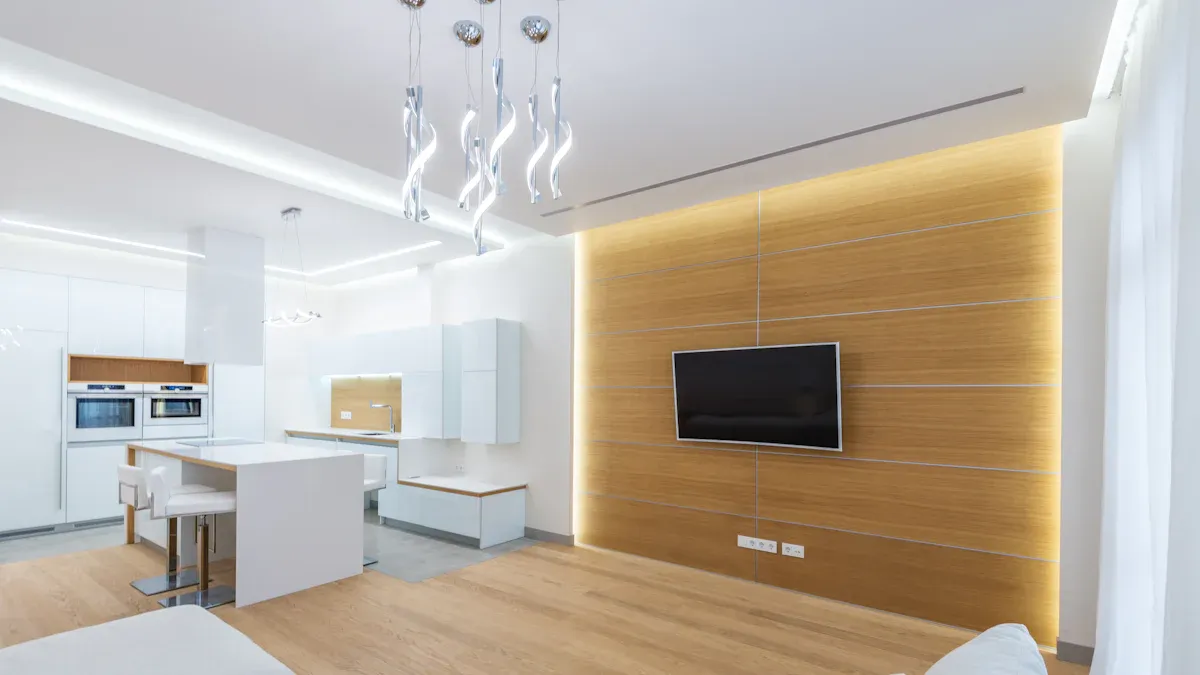
To choose LED light that perfectly fits your space, it’s important to match LED lighting to your specific needs. Commercial areas account for only 20% of installed lighting units but consume 69% of lighting electricity, while homes use 80% of units yet just 31% of energy. This highlights why selecting the right LED light and an efficient design is crucial.
Sector | % of Installed Lighting Units | % of Lighting Electricity Consumption | Key Insight |
|---|---|---|---|
Commercial | 20% | 69% | Longer hours and higher output needs mean efficient LEDs save more energy |
Residential | 80% | 31% | Shorter use times; tailored LED lighting solutions save energy at home |
High-quality LED lighting uses at least 75% less energy and lasts 25 times longer than traditional bulbs. When you choose LED light, consider factors like brightness, color temperature, CRI, fixture type, and efficiency. The right LED light enhances comfort, safety, and design in both Home and Product environments.
To learn more about our commitment to quality and innovation, visit the About Us section on our website. Whether you’re upgrading your Home lighting or exploring new Product options, we’re here to help you choose LED light solutions that meet your needs.
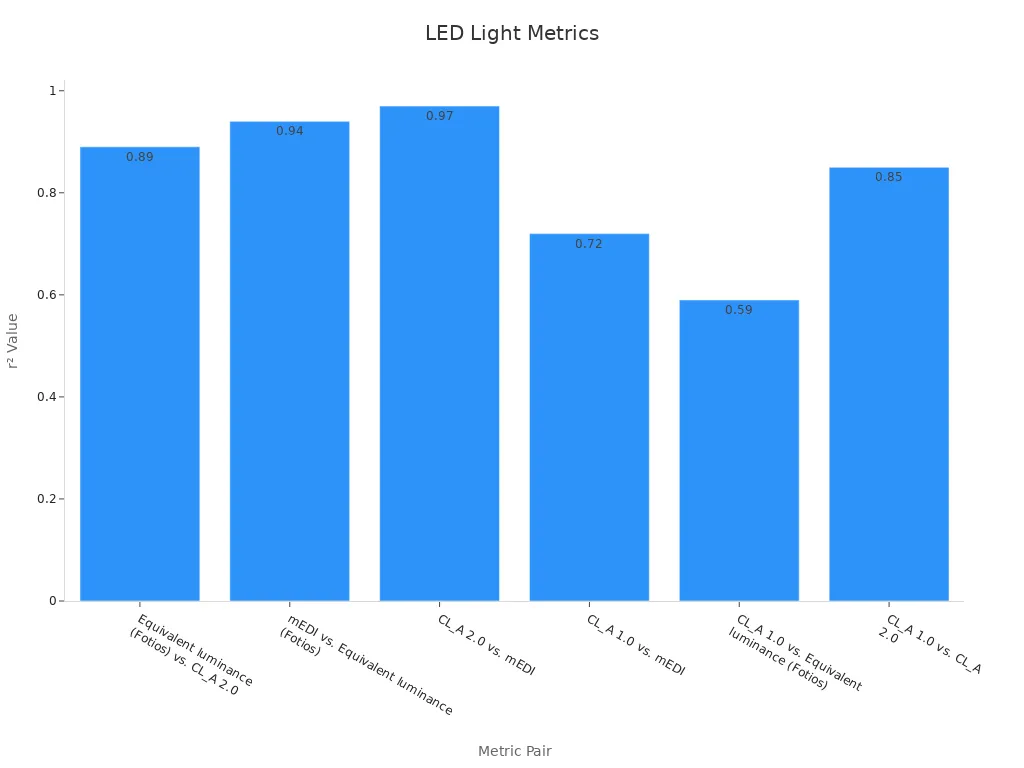
Key Takeaways
Choose LED lights based on your space’s specific needs like brightness, color temperature, and fixture type to improve comfort and safety.
Use warm light (2700K–3000K) for homes to create a cozy feel and cooler light (5000K–6500K) for commercial spaces to boost alertness.
Select LED fixtures designed for indoor or outdoor use to ensure durability and proper performance in different environments.
LED lights save energy and money by using up to 75% less power and lasting 25 times longer than traditional bulbs.
Consider smart controls and rebates to increase energy savings and reduce upfront costs while protecting your investment with good warranties.
Choose LED Light for Your Space
Lighting Needs
When you choose LED light for your space, you need to start by understanding your lighting needs. Every area has a different purpose, and the right LED lighting can improve comfort, safety, and productivity. In commercial spaces, lighting often runs for longer hours and covers larger areas. You might need high brightness and special features to support tasks, safety, and customer experience. For example, warehouses and factories need strong, uniform LED lighting to reduce shadows and glare. This helps workers see clearly and stay safe. Research shows that proper lighting in industrial and retail settings improves operational performance and worker well-being by reducing eye strain and increasing focus.
In residential spaces, lighting needs focus more on comfort and flexibility. Living rooms, bedrooms, and kitchens each require different levels of light. For example, you may want soft, dimmable LED lights in a bedroom for relaxation, but brighter LED lighting in a kitchen for cooking tasks. The recommended lighting levels for a living room range from 100 to 150 lux, while kitchens need up to 400 lux in work areas. Using dimmers and layered lighting gives you control and saves energy.
Tip: Layer your lighting with general, task, and accent LED lighting solutions to match each room’s function.
Outdoor lighting needs also vary. In commercial areas, parking lots and building entrances require high-output LED lights for safety and security. Motion sensors and smart controls help save energy by turning lights on only when needed. In residential outdoor spaces, pathway and porch lighting should provide enough brightness for safety but avoid glare and light pollution. Directional LED lighting and lower-intensity fixtures help protect the environment and support sustainability.
Space Type
The type of space you want to illuminate will guide your choice of LED lighting solutions. Commercial spaces like offices, retail stores, warehouses, and parking lots have different requirements than residential spaces such as living rooms, bedrooms, and kitchens.
Space Type | Typical Lumen Range | Application Context and Mounting Height Implications |
|---|---|---|
Hallways, Stairwells, Porches | Soft lighting for navigation, usually lower mounting heights in residential settings | |
Living Rooms, Bedrooms, Offices | 800 - 2,000 lumens | Comfortable task lighting, typical residential mounting heights |
Workshops, Garages, Retail Spaces | 2,000 - 5,000 lumens | Brighter lighting for detailed work or displays, often higher mounting in commercial spaces |
Warehouses, Factories, Stadiums | 10,000 - 50,000+ lumens | Very bright, high mounting heights needed for large commercial/industrial areas |
Commercial lighting often uses higher mounting heights and more powerful fixtures. For example, a parking lot may need LED lights with 10,000 to 15,000 lumens mounted high above the ground for wide coverage. In contrast, a residential pathway may only need 1,000 to 2,000 lumens at a lower height for safe walking. Offices benefit from LED lighting with higher color temperatures, around 6500K, which can improve alertness and task efficiency. Studies show that the right color temperature in office lighting boosts cognitive performance and comfort.
Residential lighting focuses on creating a pleasant atmosphere. Warm color temperatures (2700K to 3000K) work best in living and dining areas. Bedrooms need lower brightness and sometimes higher color rendering (CRI) for reading or relaxing. Kitchens and bathrooms require brighter, focused LED lighting for tasks.
Environment | Recommended Lux Range | Max Lux | CRI |
|---|---|---|---|
Living Room | 100-150 (general), dimmable to ~50 | N/A | N/A |
Dining Room | 150-200 (general), up to 400-500 (task) | 500 | ≥98 |
Bedroom | 50-150 (general), up to 400 (task) | 375 | ≥90 |
Kitchen | 150 (general), 400 (work areas) | 750 | ≥98 |
Bathroom | 150-300 (general), 250-300 (task) | 500 | N/A |
Hallways & Stairs | 100-150 (general), ≥100 (stairs) | 250 | N/A |
Study/Home Office | 400-500 (task), up to 750 (detailed work) | 750 | N/A |
Commercial lighting also uses different LED light distribution types. For example, Type III distribution works well for roadways and parking lots, while Type V is best for large open areas. These choices affect how high you mount the fixture and how evenly the light spreads. In residential settings, you usually use lower mounting heights and focus on comfort and style.
When you choose LED light, always match the fixture and LED lighting solution to the space type and its unique needs. This approach ensures you get the right balance of brightness, efficiency, and comfort, whether you are lighting a commercial warehouse or a cozy living room.
Brightness & Color
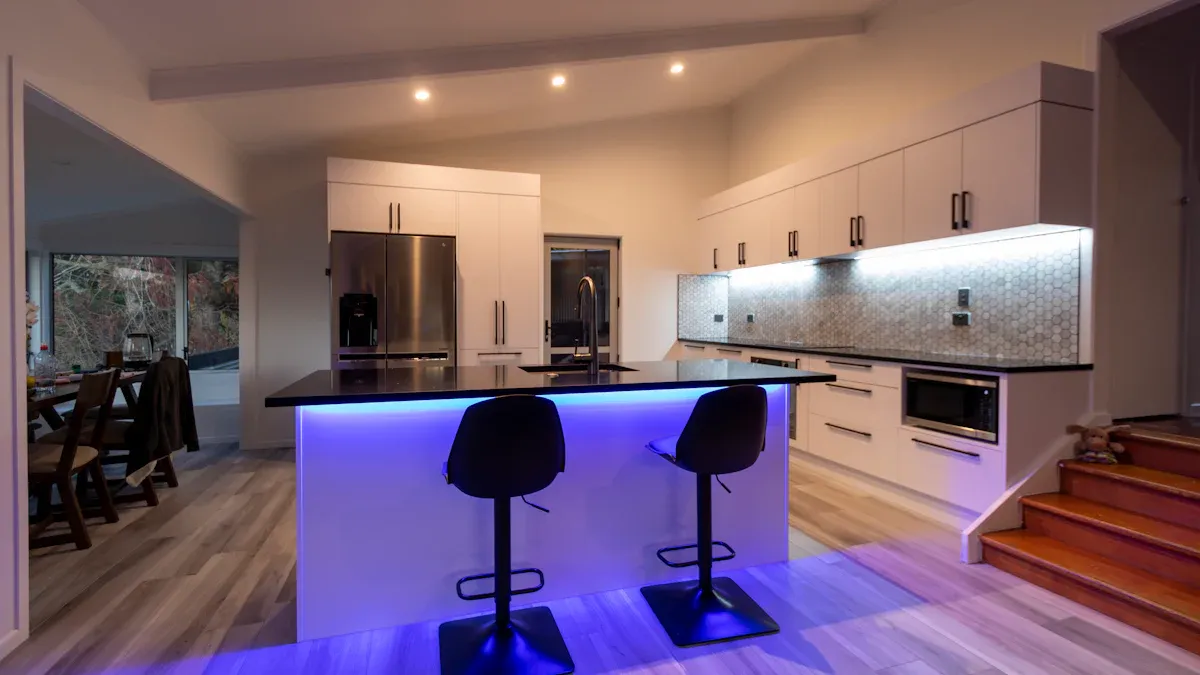
Lumens
When you choose LED lighting, you need to focus on lumens, not watts. Lumens measure the total amount of visible light a fixture produces. For residential spaces, each fixture should provide about 800 to 1,600 lumens. In commercial lighting, you often need more. Warehouses and large work areas may require 30 to 40 lumens per square foot. The function of the room affects how many lumens you need. Kitchens and workspaces need more brightness than bedrooms or hallways.
Application Area | Recommended Lumens per Square Foot | Example Calculation (12ft x 16ft room) |
|---|---|---|
General room lighting | 12 x 16 x 22 = 4,224 | |
Flooring | 20 | 12 x 16 x 20 = 3,840 |
Tables and elevated surfaces | 30 | N/A |
Desks and work tables | 50 | 12 x 16 x 50 = 9,600 |
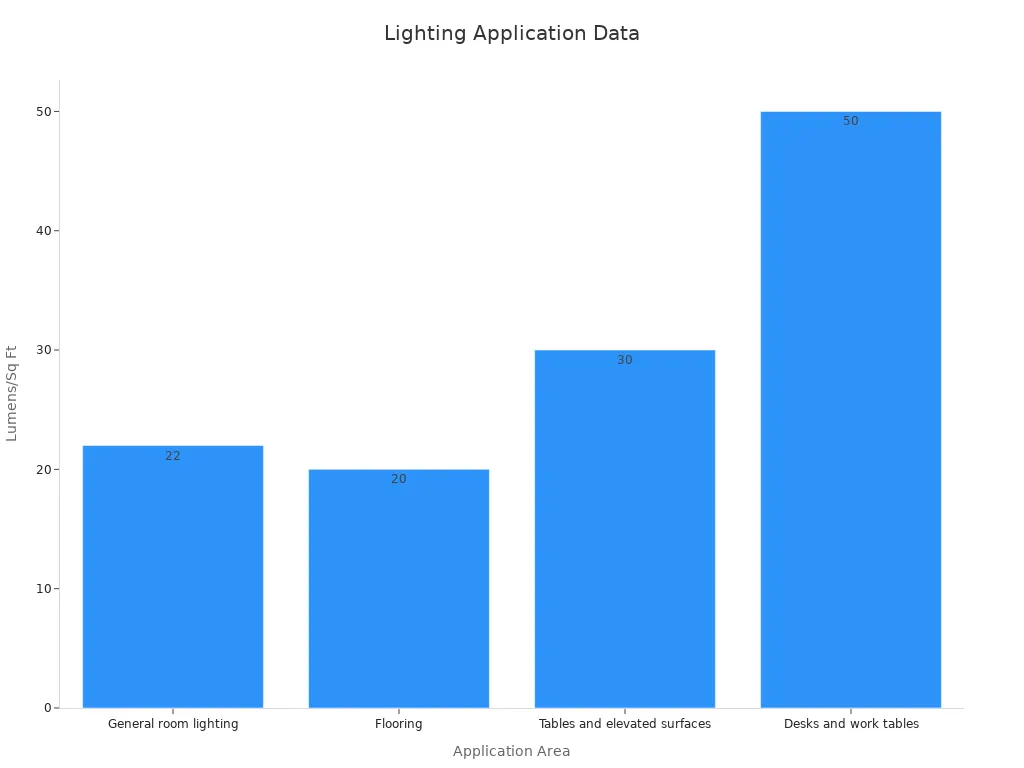
You should spread lighting across several LED fixtures for even brightness. This helps avoid shadows and dark spots. In commercial spaces, industry standards suggest 300 to 750 lux for most tasks. Some areas, like inspection stations, need up to 1,000 lux.
Color Temperature
Color temperature affects how a space feels. You measure it in Kelvin (K). Warm light (2,700K to 3,000K) works best for residential areas like living rooms and bedrooms. It creates a cozy, relaxing mood. Neutral white (3,500K to 4,100K) fits offices and retail spaces. Cool white (5,000K to 6,500K) suits commercial and industrial lighting, where you need clear visibility and alertness.
Typical Use Environment | Purpose and Effect on Space and Users | |
|---|---|---|
2200K - 2700K | Residential, Hospitality, Dining | Creates warm, cozy, inviting atmospheres; promotes relaxation and melatonin release; mimics incandescent or candlelight |
3000K | Residential (bathrooms, kitchens) | Balances warmth and functionality; comfortable yet clear visibility for tasks |
3500K - 4100K | Offices, Retail | Neutral white light supporting clarity, focus, and productivity |
5000K | Offices, Classrooms, Industrial | Daylight-like bright illumination; energizing atmosphere to boost productivity and attention to detail |
6500K | Industrial, Hospitals, Outdoor | Cool white, bluish light for high visibility, safety, precision, and task performance |
Cooler color temperatures help people stay alert in commercial lighting. Warmer tones help you relax at home.
CRI
Color Rendering Index (CRI) shows how well a light source displays colors. The scale goes from 0 to 100. Higher CRI means better color accuracy. For most residential and commercial lighting, you should choose LED lighting with a CRI of 80 or higher. In retail, art galleries, and healthcare, a CRI above 90 is best. This ensures true color appearance and supports tasks that need precise color matching.
Application Area | Recommended CRI Range | Purpose / Reasoning |
|---|---|---|
Art Galleries and Museums | 95-99+ | Preserve color integrity and enhance artwork appearance; critical for accurate color rendering. |
Premium Retail Stores | 95-98 | Enhance product appearance and customer appeal through accurate color representation. |
General Residential Use | ~90 | Balance between color accuracy and energy efficiency for comfortable living environments. |
Offices (general work) | 90 | Suitable for general tasks; moderate color accuracy needed. |
Offices (color work) | 97 | For design studios, photography, and color-critical tasks requiring high fidelity. |
Medical Applications | 90-99 | From general clinics (90) to hospitals (99), precise color differentiation supports diagnostics. |
Hospitality (cafés, hotels) | 95 | Create inviting atmospheres with accurate color rendering. |
Outdoor, Street Lighting | 70-80 | Lower CRI acceptable where color accuracy is less critical. |
Tip: High CRI LED lighting improves comfort and makes spaces look more natural. Choose the right CRI for your lighting needs.
LED Lighting Fixtures
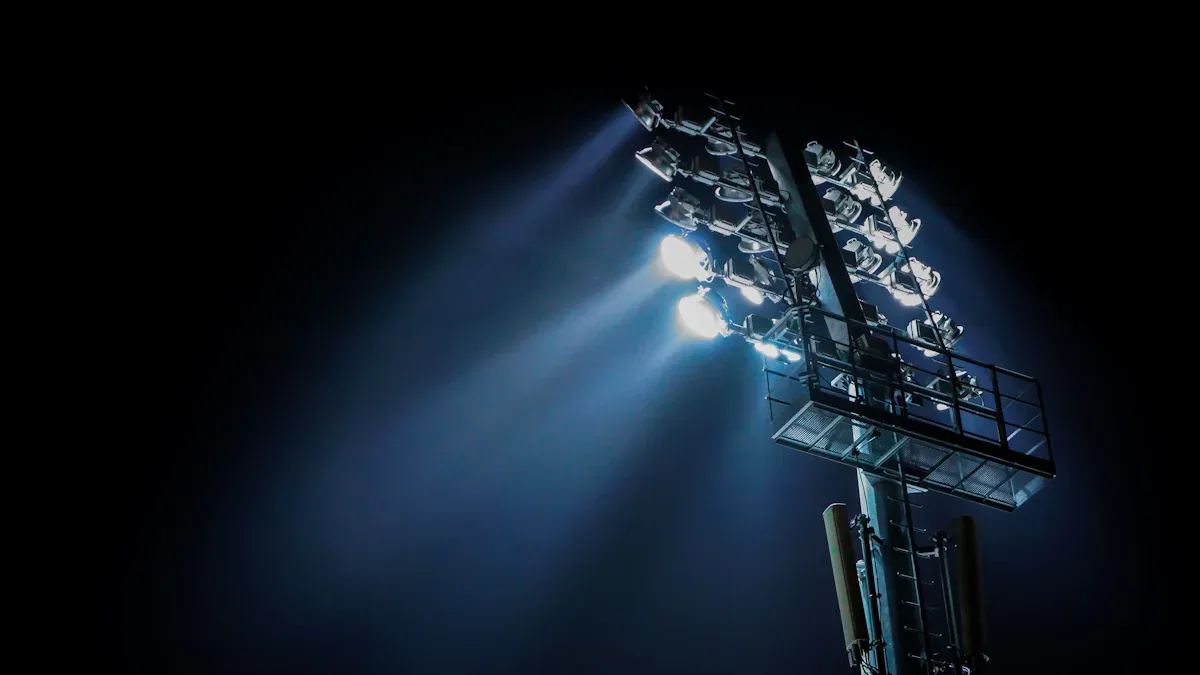
Fixture Types
You can choose from many types of LED lighting fixtures for both commercial and residential spaces. Panels work well in offices and classrooms, giving even lighting across large areas. Strips offer flexible LED lighting solutions for accent lighting under cabinets or along stairs. Bulbs fit into most standard sockets and replace old lighting easily. Floodlights provide strong outdoor lighting for parking lots or building exteriors. Downlight fixtures, such as recessed or surface-mounted options, give focused light for living rooms, kitchens, and hallways. Each type of LED light has a unique design and purpose. Reviews and studies show that you should check brightness, color temperature, and lifespan before buying. Always look for LED fixtures from trusted brands with good warranties. Customer reviews and real-world case studies help you understand how well a fixture performs over time.
Indoor vs Outdoor
Indoor and outdoor LED lighting fixtures have different needs. Indoor fixtures do not need weatherproofing. You can use standard materials and focus on design and comfort. Outdoor LED lights must handle rain, dust, and extreme temperatures. Look for high IP ratings, like IP65, to ensure durability. Outdoor fixtures often use strong, corrosion-resistant materials and last longer, sometimes up to 150,000 hours. Many outdoor LED lighting solutions include motion sensors or timers for safety and energy savings. The table below shows key differences:
Aspect | Outdoor LED Fixtures | Indoor LED Fixtures |
|---|---|---|
Durability & Weather Resistance | High IP ratings, weatherproof, corrosion-resistant materials | Standard materials, no weatherproofing needed |
Lifespan | Up to 150,000 hours | Shorter lifespan |
Features | Motion sensors, timers, remote controls | Simpler features |
Installation | GFCI outlets, moisture-proof seals | Standard installation |
Installation
Proper installation ensures your LED lighting works safely and efficiently. Always check the bulb base and mounting type before you start. Use adjustable fixtures to direct light where you need it. For outdoor lighting, use GFCI outlets and seal all connections to prevent moisture problems. Follow local codes and turn off power at the breaker before working. For commercial spaces, consider a photometric analysis to plan your lighting design. Position downlight fixtures to avoid glare and shadows. Choose LED lighting solutions with smart controls, like dimmers or motion sensors, to save energy. Regularly inspect your LED fixtures for signs of wear or damage. If you face challenges like wiring issues or flickering, consult a professional. Good installation helps your lighting last longer and keeps your space safe.
Efficiency & Features
Energy Star & Certifications
You can boost the efficiency of your lighting by choosing products with ENERGY STAR certification. ENERGY STAR certified lighting has helped save over 5 trillion kilowatt-hours of electricity since 1992. This program has also prevented billions of metric tons of greenhouse gas emissions. Nearly 90% of American households recognize the ENERGY STAR label, which stands for quality and energy efficiency. Even as some lighting categories phase out this certification, you can still find the Lighting Facts label to help you compare products. ENERGY STAR certified lighting gives you peace of mind about performance and energy savings.
Impact Category | Since 1992 Impact | 2020 Impact |
|---|---|---|
Electricity Savings | 5 trillion kilowatt-hours | 520 billion kilowatt-hours |
Energy Cost Savings | Over $500 billion | $42 billion |
Greenhouse Gas Emissions | 4 billion metric tons prevented | 400 million metric tons prevented |
Product Sales | Over 500 million ENERGY STAR certified bulbs sold in 2021 | N/A |
Lifespan
LED lighting stands out for its long lifespan and high efficiency. You can expect most LED lighting fixtures to last between 25,000 and 50,000 hours, much longer than incandescent bulbs, which last about 1,000 hours. Industry standards like LM-80 and TM-21 help test and predict how long LED lighting will perform well. The DesignLights Consortium sets a minimum rating of 50,000 hours for compliant fixtures. Real-world lifespan depends on the quality of the LED driver and the environment. High-quality LED lighting means fewer replacements and less maintenance, which saves you money and supports energy-efficient lighting.
Tip: Choosing energy-efficient lighting with a long lifespan reduces waste and lowers your total cost of ownership.
Feature | LED Lighting | Incandescent Lighting |
|---|---|---|
Lifespan (hours) | 25,000 to 50,000 | ~1,000 |
Energy Consumption | Up to 85% less energy | Baseline (100%) |
Replacement Frequency | Much lower | High |
Smart Controls
Smart controls take the efficiency of LED lighting to the next level. You can use sensors, timers, and dimmers to adjust lighting based on occupancy or daylight. Studies show that smart controls can reduce total building energy use by up to 20%. In some cases, combining LED lighting with smart controls has cut energy use by more than 50%. For example, a port that used smart outdoor lighting reduced its annual lighting energy demand by 56.8%. Smart controls also improve safety, comfort, and maintenance. By using smart features, you make your lighting system more flexible and energy-efficient.
Smart controls help you save energy, lower costs, and support sustainability goals.
Right LED Light & Budget
Upfront vs Long-Term Cost
When you choose the right led light for your space, you need to look beyond the initial price tag. Upfront costs include the purchase price, installation fees, and sometimes new fixtures or smart controls. These expenses may seem high at first, but you gain much more over time.
LED lighting uses about 75% less energy than older bulbs. This means you save on your monthly bills.
The lifespan of LED lights can reach up to 50,000 hours. You will not need to replace them as often, which lowers maintenance costs.
LEDs give off less heat. This helps keep rooms cooler and reduces air conditioning costs, especially in commercial buildings.
Many businesses see a return on investment in less than two years. Some save up to $100 per bulb each year.
You can see the difference in costs and savings in the table below:
Factor | LED Street Lights | Traditional Street Lights |
|---|---|---|
$100 – $1,000 | $100 – $600 | |
Lifespan (hours) | 50,000 – 100,000 | 12,000 – 24,000 |
Annual Maintenance Cost | $20 – $50 | $100 – $250 |
Energy Efficiency | 50-70% energy savings | Moderate to low |
Choosing the right led light boosts energy efficiency and reduces long-term expenses. You also help the environment by lowering carbon emissions.
Rebates & Warranty
You can lower your upfront costs by taking advantage of rebates and incentives. Many utility companies and government programs offer rebates for energy-efficient lighting upgrades. These programs help you recover your investment faster. Some manufacturers also provide discounts or special offers for bulk purchases.
Tip: Always check for local or state rebates before you buy new lighting. This can make your project more affordable.
Warranty is another important part of your decision. High-quality lighting products often come with warranties of five years or more. A strong warranty protects your investment and ensures your lighting design will last. If you ever have a problem, you can get repairs or replacements at no extra cost.
When you choose the right led light, you make a smart investment in energy efficiency, cost savings, and reliable lighting design for years to come.
Choosing the right LED area light means looking at function, aesthetics, and efficiency together. You can follow these steps to make the best choice:
High CRI values (80+ for most, 90+ for color-critical spaces) improve both looks and performance.
Efficient LEDs (80-150 lm/W) save up to 70% more energy than old bulbs.
Smart controls can cut energy costs by up to 80%.
LEDs last 25 times longer, so you save money over time.
Assess your lighting needs today. If you feel unsure, talk to a lighting professional for guidance.
FAQ
What is the best color temperature for home lighting?
You should choose warm white (2,700K–3,000K) for living rooms and bedrooms. This range creates a cozy and relaxing feel. For kitchens and bathrooms, use neutral white (3,500K–4,100K) to help you see details clearly.
How do I know how many lumens I need?
Measure your room’s square footage. Multiply by the recommended lumens per square foot (usually 20–30 for homes). For example, a 10x12 room needs about 2,400–3,600 lumens. Use multiple fixtures to spread light evenly.
Can I use indoor LED lights outside?
No, you should not use indoor LED lights outdoors. Outdoor lights have weatherproofing and higher IP ratings. Indoor lights may fail quickly if exposed to rain, dust, or extreme temperatures.
Do LED lights save money over time?
Yes, LED lights use less energy and last much longer than traditional bulbs. You will pay less for electricity and buy fewer replacements. Over time, you save money and reduce waste.
See Also
Tips For Selecting Ideal LED Lighting In Commercial Spaces
Guide To Picking The Best LED Replacement For Any Property
Everything You Need To Know About LED Area Lighting Solutions
Choosing The Best LED Street Lighting For Neighborhoods In 2025

